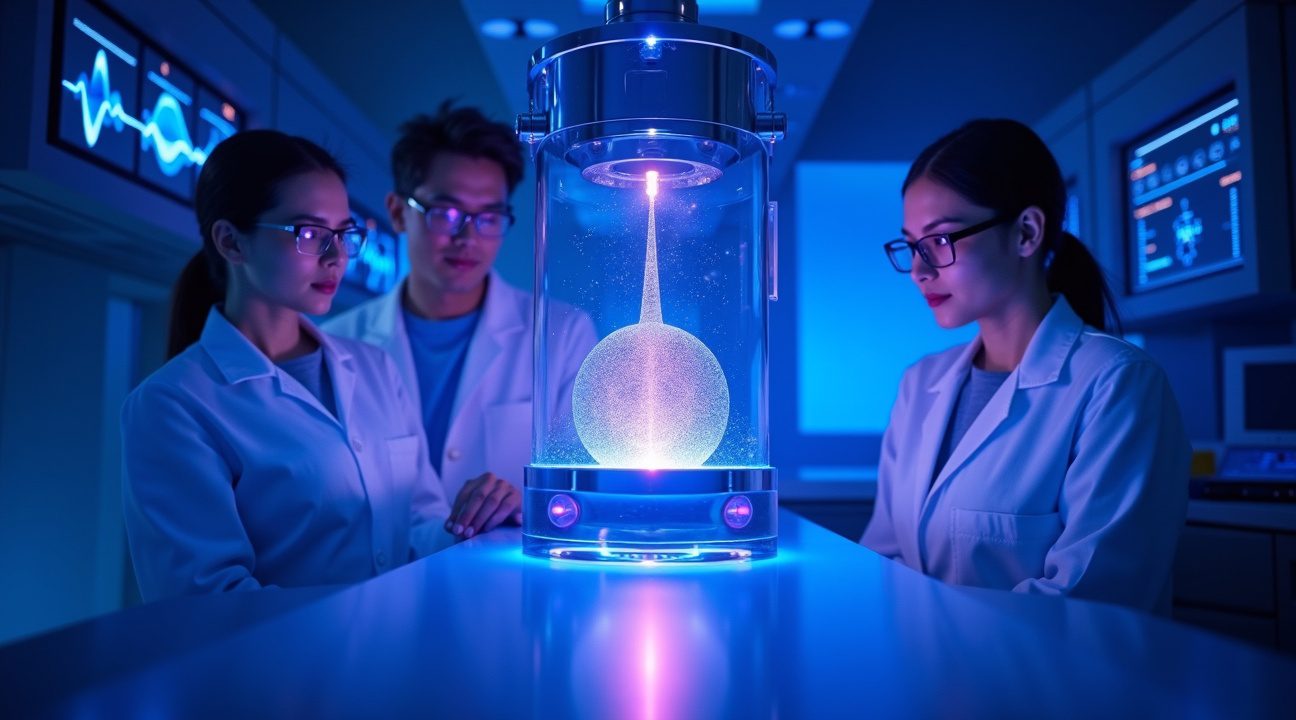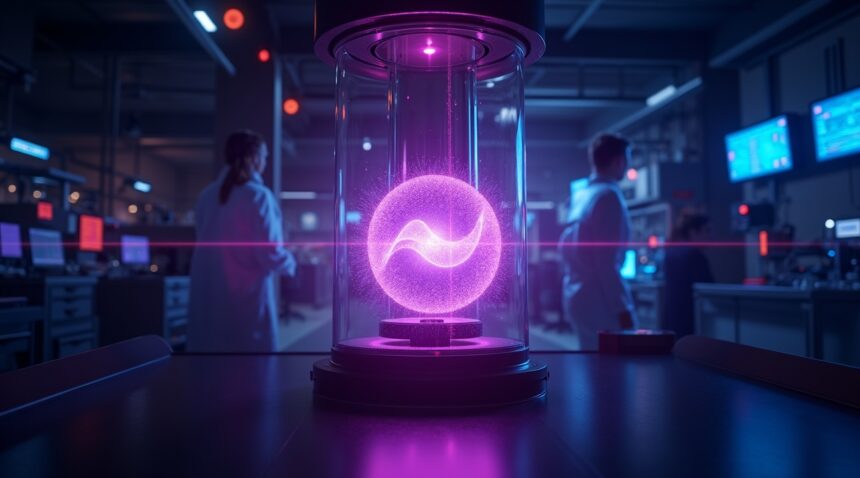Scientists at Washington State University made a groundbreaking discovery in 2017 by developing fluids with negative mass properties—substances that accelerate toward applied forces instead of moving away from them.
Key Takeaways
- Negative mass fluid was created using rubidium atoms cooled to temperatures just above absolute zero, forming a Bose-Einstein condensate that defies classical motion laws.
- The experiment utilized advanced techniques such as laser cooling, magnetic field manipulation, and spin-orbit coupling to control atomic behavior at quantum scales.
- Quantum fluids like these help simulate cosmic environments such as black holes and neutron stars within laboratory conditions, enhancing our understanding of the universe.
- The discovery challenges traditional physics theories and has promising implications for future research in quantum computing, precise measurement, and innovative propulsion technologies.
- Negative mass arises from quantum mechanical interactions where atoms move collectively as a single entity, acting contrary to Newtonian expectations.
Further Reading
For more details on the research, visit the official Washington State University announcement of the experiment.
Rubidium Atoms Accelerate Backward When Pushed in Groundbreaking 2017 Experiment
Scientists at Washington State University achieved something that sounds like science fiction in 2017. They created a fluid that behaves as if it has negative mass, challenging fundamental assumptions about how matter responds to force. Physics principles that have guided understanding for centuries suddenly appeared less absolute.
The experiment involved cooling rubidium atoms using lasers to temperatures approaching absolute zero. This extreme cooling process created what scientists call a Bose-Einstein condensate (BEC), a quantum state where individual atoms lose their separate identities and begin moving collectively as a single wave. Think of it as thousands of dancers suddenly moving in perfect synchronization, creating something entirely new from their collective behavior.
Creating the Impossible: Negative Mass in Action
The condensate itself measured only 50-100 microns across, making it significantly smaller than a typical water droplet. Despite its minuscule size, this quantum fluid demonstrated behavior that defied Newton’s laws. When researchers applied force to push the condensate, it accelerated backward toward the source of the force rather than away from it.
This backwards acceleration represents a complete reversal of expected behavior. Imagine pushing a ball and watching it roll toward your hand instead of away from it. The rubidium condensate exhibited exactly this type of counterintuitive motion, moving in the opposite direction that classical physics would predict.
Quantum Mechanics Makes the Impossible Possible
The secret lies in quantum mechanics and the unique properties of the Bose-Einstein condensate. At such extreme temperatures, the atoms exist in a superfluid state where quantum effects dominate over classical physics. The collective wave function of the condensate allows it to exhibit properties that individual atoms cannot possess.
Scientists had theorized about negative mass behavior for decades, but this marked the first experimental demonstration of such phenomena. The research team published their findings in Physical Review Letters, establishing a new benchmark for experimental physics. Their work proved that theoretical concepts from quantum mechanics could manifest in observable, measurable ways.
The experiment required precise control over temperature, magnetic fields, and laser configurations. Researchers used sophisticated cooling techniques to reach temperatures just billionths of a degree above absolute zero. At these temperatures, thermal motion nearly stops, allowing quantum effects to become dominant.
The implications extend far beyond academic curiosity. Understanding negative mass behavior could lead to advances in quantum computing, precision measurement devices, and even theoretical propulsion systems. Scientists think such quantum phenomena might help explain other mysterious aspects of physics.
The Washington State University team’s achievement demonstrates how modern experimental techniques can bring theoretical concepts into reality. Their success required combining multiple cutting-edge technologies:
- Laser cooling systems
- Magnetic field controls
- Precise measurement equipment capable of detecting microscopic motion
Future experiments will likely build on this foundation, exploring how negative mass fluids interact with gravity, electromagnetic fields, and other quantum systems. The 2017 breakthrough opened new avenues for research that were previously impossible to pursue experimentally.
This discovery represents more than just confirming theoretical predictions. It showcases humanity’s ability to manipulate matter at the quantum level, creating substances that behave in ways that seem to violate common sense. The rubidium condensate experiment stands as proof that the quantum world operates by rules fundamentally different from everyday experience.
The research continues to influence how scientists approach quantum mechanics experiments and theoretical physics. By successfully creating negative mass behavior in a laboratory setting, the Washington State University team provided a concrete example of how quantum mechanics can produce effects that classical physics cannot explain.
https://www.youtube.com/watch?v=zvYKo41jRKE

Negative Mass Objects Defy Newton’s Second Law by Moving Toward Applied Forces
Traditional physics teaches that when I push an object, it moves away from me. This fundamental principle stems from Newton’s Second Law, which states that force equals mass times acceleration (F = ma). However, negative mass fluids completely overturn this basic understanding by accelerating in the opposite direction — challenging established physics principles at their core.
When scientists apply force to a negative mass object, something extraordinary happens. Instead of moving away from the applied force, the object accelerates directly into it. This counterintuitive behavior flips Newton’s Second Law on its head. In mathematical models, researchers represent negative mass as -1 kg, which creates acceleration patterns that contradict everything we observe in everyday life.
Perpetual Motion and Conservation Paradoxes
The implications become even more fascinating when positive and negative mass pairs interact. These combinations create scenarios where objects accelerate indefinitely while maintaining zero total momentum and energy. Consider this remarkable phenomenon: I could theoretically place a positive mass object next to a negative mass object, and they would chase each other through space forever, with the negative mass perpetually pursuing the positive mass that’s trying to escape.
This creates several mind-bending paradoxes that challenge our understanding of conservation laws:
- Total momentum remains zero despite continuous acceleration
- Energy conservation appears violated yet mathematically balances out
- Runaway motion occurs without external energy input
- Causality violations become theoretically possible
These behaviors suggest that negative mass could enable the creation of perpetual motion machines, devices that have long been considered impossible under conventional physics. The mathematical framework supports these scenarios while maintaining conservation principles, though the practical implications remain theoretical.
Einstein’s general relativity also faces significant challenges from negative mass concepts. The theory assumes that mass curves spacetime in predictable ways, but negative mass would theoretically curve spacetime in the opposite direction. This creates gravitational repulsion rather than attraction, fundamentally altering how we understand gravity’s role in the universe.
Recent research has demonstrated that scientists can create fluid systems exhibiting negative mass properties under controlled laboratory conditions. These experiments don’t violate established physics laws but rather reveal new boundaries and test cases for existing equations. The work opens up possibilities for understanding exotic matter states that could exist in extreme cosmic environments or theoretical scenarios involving space exploration technologies.
The study of negative mass continues to push the boundaries of theoretical physics, offering insights into the fundamental nature of matter, energy, and the forces that govern our universe.

Laser Cooling and Spin-Orbit Coupling Create Quantum Fluid with Bizarre Properties
Creating fluids that defy Newton’s laws requires pushing matter to its quantum limits. I find it fascinating how researchers manipulate rubidium atoms at temperatures just above absolute zero to achieve this extraordinary feat. The process begins with laser cooling, where scientists use precisely tuned light beams to slow atomic motion to nearly zero.
Researchers confine these ultracold rubidium atoms in what they call a ‘bowl’ — essentially an optical trap created by intersecting laser beams. Within this confined space, they can manipulate the quantum state of thousands of atoms simultaneously. The key breakthrough comes from engineering effective negative mass through careful control of atomic properties rather than creating actual negative mass particles.
Spin-Orbit Coupling Triggers the Negative Mass Effect
The critical innovation involves spin-orbit coupling, where additional lasers manipulate the intrinsic angular momentum (spin) of individual atoms. This technique allows scientists to create artificial magnetic fields that fundamentally alter how atoms interact with each other. When researchers apply this spin-orbit coupling to the trapped atoms, they induce conditions where the collective behavior mimics negative mass.
The resulting Bose-Einstein condensate serves as the perfect medium for observing quantum effects on a scale visible to the naked eye. Unlike normal matter where quantum behaviors remain hidden at the microscopic level, this quantum fluid amplifies these effects dramatically. The negative mass properties emerge from a quantum phase transition that occurs when scientists fine-tune the strength of atomic interactions using magnetic fields and laser parameters.
What makes this achievement particularly remarkable is how the fundamental physics principles we understand get turned on their head. Traditional fluids accelerate away from applied forces, but these quantum fluids accelerate directly into them. The effect stems from the collective quantum state of all atoms acting as a single entity rather than individual particles responding independently.
Temperature control remains absolutely critical throughout this process. Even tiny thermal fluctuations can destroy the delicate quantum coherence necessary for negative mass behavior. Scientists maintain temperatures around 100 nanokelvin — nearly three billion times colder than room temperature — to preserve the quantum state.
The precision required for this manipulation rivals any modern technological achievement. Researchers must coordinate multiple laser systems, magnetic field generators, and temperature controls with extraordinary accuracy. Small variations in any parameter can cause the quantum fluid to lose its negative mass properties and revert to conventional behavior.

Laboratory Models of Black Holes and Neutron Stars Now Possible
The creation of negative mass fluids opens unprecedented opportunities for scientists to recreate some of the universe’s most extreme environments within controlled laboratory settings. These artificial materials enable researchers to simulate conditions found in neutron stars, black holes, and other exotic cosmic phenomena that were previously impossible to study directly on Earth.
Simulating Extreme Cosmic Environments
Negative mass fluids serve as powerful analogs for investigating gravitational anomalies and testing fundamental physics principles. Scientists can now manipulate effective mass properties to replicate the intense gravitational fields surrounding black holes, allowing them to observe how matter behaves under such extreme conditions. This capability extends to modeling neutron star environments, where matter exists in states so dense that conventional physics breaks down.
The research applications span far beyond basic cosmic simulation. Scientists use these fluids to investigate mysterious phenomena like dark energy, which comprises roughly 70% of the universe yet remains poorly understood. By creating laboratory conditions that mimic dark energy’s repulsive effects, researchers gain valuable insights into this cosmic mystery without requiring expensive space-based observations.
Breakthrough Research Tools and Future Applications
These negative mass systems function as versatile research platforms for probing fundamental laws that govern our universe. Scientists can test Einstein’s general relativity under controlled conditions, examine quantum field theories, and explore gravitational interactions that typically occur only in the most extreme cosmic environments. The ability to switch between positive and negative effective mass states provides researchers with an adjustable laboratory tool of remarkable precision.
The technological implications extend far beyond academic research, though practical applications remain largely speculative. Scientists envision potential breakthroughs in:
- Propulsion systems
- Energy storage
- Time manipulation technologies
Some researchers suggest these fluids could lead to revolutionary advances comparable to how liquid robotics transformed material science.
Current experiments focus on understanding how these fluids interact with conventional matter and energy fields. Research teams investigate whether negative mass fluids could theoretically enable faster-than-light communication or create stable wormhole-like structures in laboratory settings. While such concepts remain highly theoretical, the controlled nature of these experiments allows scientists to test predictions that were previously relegated to pure mathematics.
The implications for space exploration are particularly intriguing. Just as NASA’s slingshot projects revolutionized spacecraft propulsion, negative mass fluids could potentially enable entirely new approaches to space travel. Scientists theorize about propulsion systems that don’t require traditional fuel sources, instead using the unique properties of negative mass to generate thrust.
These research tools also provide new perspectives on fundamental questions about reality itself. Scientists can now investigate whether the laws of physics remain consistent when dealing with matter that behaves contrary to our everyday experience. The experiments probe the boundaries between classical and quantum mechanics, potentially revealing new physics principles that govern matter under extreme conditions.
Research teams continue expanding their understanding of how these fluids might replicate other cosmic phenomena. Scientists explore whether they can model the conditions found in the deepest environments of space, where pressures and temperatures reach unimaginable extremes. Some investigations focus on recreating the chemical processes that occur in stellar cores, where life’s building blocks might form under conditions impossible to replicate through conventional means.
While breakthrough applications remain years or decades away, the immediate scientific value proves undeniable. These negative mass fluids provide researchers with laboratory access to physics regimes that previously existed only in theoretical models or distant cosmic observations. Each experiment brings scientists closer to understanding the fundamental nature of mass, gravity, and the exotic matter that shapes our universe’s most extreme environments.
https://www.youtube.com/watch?v=P3WALvxz7bY
Sources:
Ecoportal, “Scientists manage to create negative mass”
New Atlas, “Scientists create negative-mass fluid that flows against the force”
Ohmbound, “Negative Mass Fluids: A Window into Exotic Physics?”
Wikipedia, “Negative mass”
Independent Physics, “Does antimatter fall down? and negative mass”


